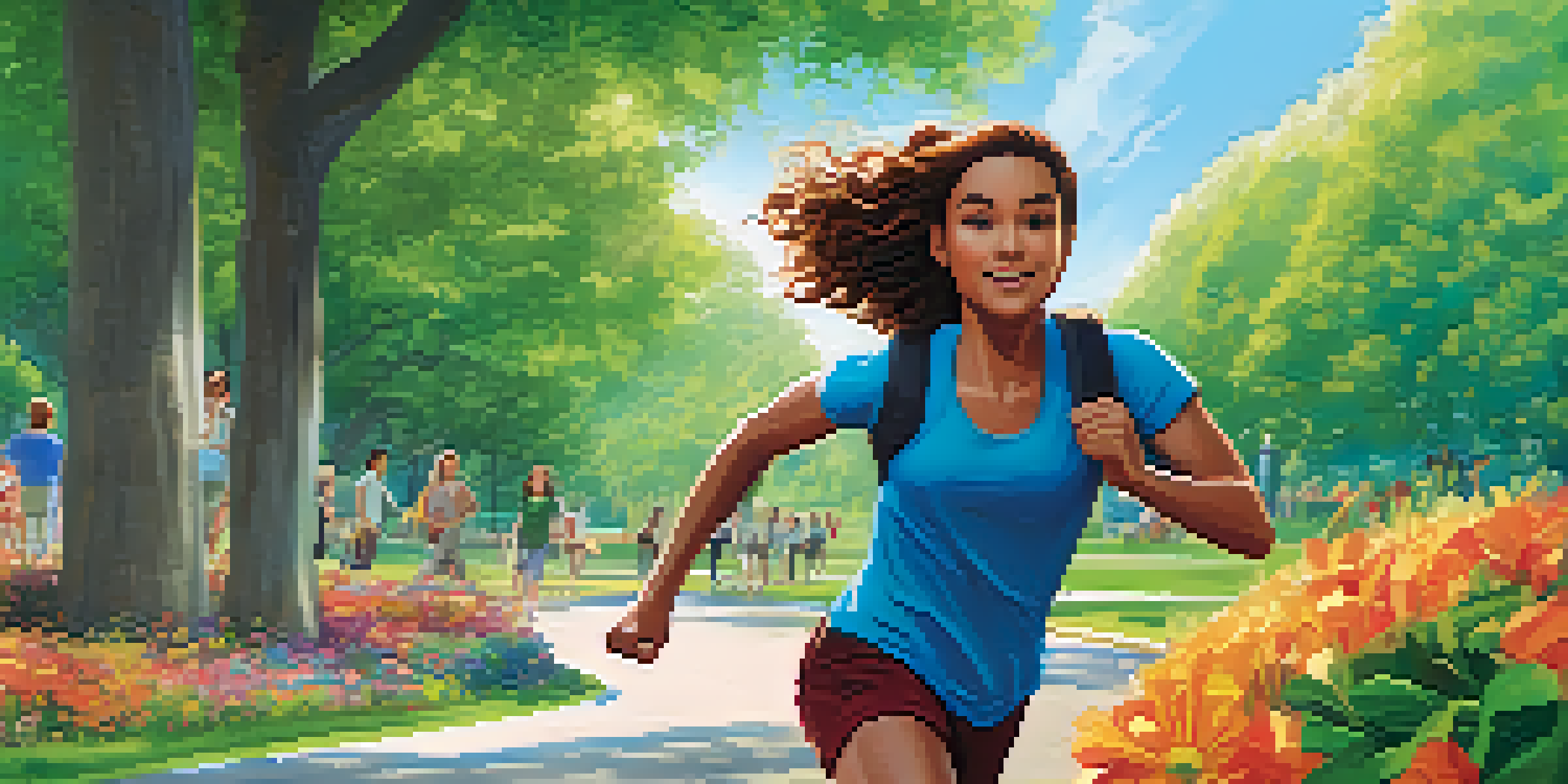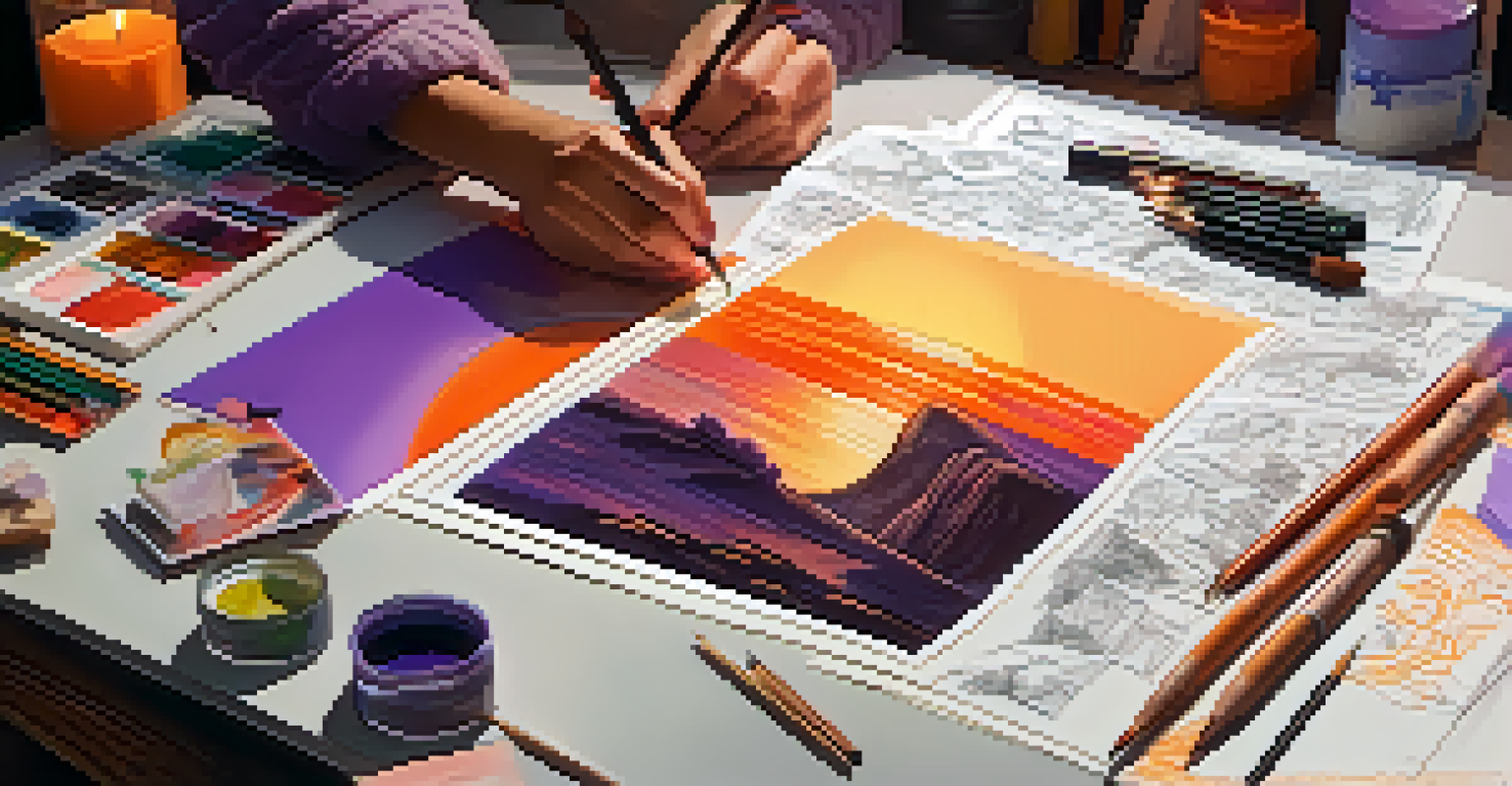Understanding the Storyboarding Process for Filmmakers

What is Storyboarding and Why is it Important?
Storyboarding is the process of creating a visual outline for your film, typically in a series of sketches or images. It serves as a blueprint that guides filmmakers through each scene, helping to visualize the narrative before actual filming begins. Think of it as a comic strip for your movie; each panel represents a crucial moment in the story.
A storyboard is a visual representation of your story, serving as a blueprint for production.
By laying out the scenes, filmmakers can better organize their thoughts and ensure a coherent flow of action. This visual representation allows for easier identification of pacing issues or awkward transitions. Moreover, it provides a clear roadmap for the crew, making it easier to coordinate efforts during production.
In essence, storyboarding not only enhances creativity but also saves time and resources on set. When everyone understands the vision, it leads to more efficient shooting and fewer misunderstandings. So, whether you're an indie filmmaker or part of a big studio, storyboarding can significantly impact the quality of your final product.
The Basic Elements of a Storyboard
A storyboard typically consists of several key elements, including images, captions, and notes about camera angles. Each frame usually represents a shot, depicting characters, backgrounds, and the action taking place. Captions can include dialogue, sound effects, or any visual cues that are important for the scene.

For instance, if a character is running through a park, the storyboard might feature an image of the park, alongside notes about the camera following the character from behind. This helps the director visualize how the scene will unfold and what the audience will see. Additionally, incorporating details like timing can also be beneficial for pacing the scene effectively.
Storyboarding Enhances Filmmaking
Storyboarding serves as a visual blueprint that guides filmmakers, improving organization and communication throughout the production process.
Incorporating these elements into your storyboard not only clarifies your vision but also assists in communicating your ideas to the entire team. Everyone from the director to the cinematographer can refer back to the storyboard, ensuring that everyone is on the same page and working towards the same creative goal.
How to Create a Storyboard: Step-by-Step Guide
Creating a storyboard can be broken down into several manageable steps. Start by reading through your script thoroughly, identifying key scenes and moments that require visual representation. Once you've pinpointed these, sketch out rough images of each scene, focusing on how you envision the action unfolding.
Storyboarding is not just a tool for organization; it's a means to bring your creative vision to life.
Next, add details to each frame, such as character expressions, camera angles, and any necessary dialogue. This is where your creativity can shine, as you decide how to visually communicate your story. Remember, it doesn't have to be perfect—stick figures can work just as well as detailed drawings, as long as the concept is clear.
Finally, review your storyboard with your team to gather feedback and make adjustments as necessary. Collaboration can lead to new ideas that enhance your original vision. This iterative process is crucial in refining your storyboard into a tool that effectively communicates your film's story.
Digital vs. Traditional Storyboarding Methods
Storyboarding can be executed using traditional methods, like pen and paper, or through digital tools, each with its own set of advantages. Traditional methods allow for a hands-on approach, giving filmmakers the freedom to express their ideas quickly. However, this can sometimes lead to messy sketches that are hard to interpret later on.
On the other hand, digital storyboarding software offers features like easy editing, layering, and even animation effects. Tools like Storyboard That or Adobe Photoshop can enhance the clarity of your vision, making it easier to share with others. Plus, digital storyboards can be stored and accessed more easily, allowing for quick updates.
Key Elements of a Storyboard
A storyboard includes images, captions, and notes about camera angles, clarifying the vision and ensuring all team members are aligned.
Ultimately, the choice between traditional and digital methods comes down to personal preference and the needs of your project. Whichever route you choose, the goal remains the same: to create a clear visual representation of your film that guides your production process.
Common Mistakes to Avoid When Storyboarding
Even experienced filmmakers can fall into common traps when storyboarding. One major mistake is overcrowding the storyboard with too much detail, making it hard to understand the flow of action. While it’s important to convey the essence of each scene, clarity should always take precedence over intricate drawings.
Another pitfall is neglecting to consider the pacing of the scenes. A storyboard should reflect not just the action, but also the timing and rhythm of the narrative. If scenes are too rushed or drawn out, it can disrupt the audience's engagement and lead to an unsatisfying viewing experience.
Lastly, failing to collaborate with your team can hinder the effectiveness of your storyboard. Sharing your ideas and getting input from others can lead to a more cohesive vision. Remember, a storyboard is a collaborative tool designed to help everyone involved in the project.
Using Storyboards for Different Types of Filmmaking
Storyboarding isn't just for narrative films; it's a versatile tool that can be used in various types of filmmaking, including documentaries and animations. For documentaries, storyboards can help outline key interviews and visual sequences, ensuring that the narrative remains focused and engaging. This preparation allows filmmakers to capture essential moments without missing a beat.
In animation, storyboarding plays an even more critical role, as it outlines every frame of the animated sequence. Animators can visualize movement, dialogue, and transitions, which is crucial for maintaining continuity. A well-crafted storyboard in animation serves as a foundation upon which all other elements are built.
Collaboration is Crucial
Involving your team in the storyboarding process fosters collaboration, leading to a more cohesive vision and ultimately a better film.
Regardless of the genre, storyboarding enhances the storytelling process by providing a visual roadmap. It encourages filmmakers to think critically about their narrative and how best to convey it, ultimately leading to a more polished and professional final product.
The Role of Storyboards in Pre-Production
In the pre-production phase, storyboards are invaluable for planning and organization. They help streamline the scheduling by allowing filmmakers to determine the number of shots needed for each scene. This information is crucial for budgeting and allocating resources effectively, ensuring that everything runs smoothly during filming.
Moreover, storyboards facilitate communication among departments, including production design, cinematography, and even the cast. A clear visual guide helps everyone understand the director's vision and allows for more efficient collaboration. This shared understanding can significantly enhance the creative process.

Ultimately, the role of storyboards in pre-production cannot be overstated. They act as a glue that binds various aspects of the filmmaking process, leading to a more cohesive and successful production experience.